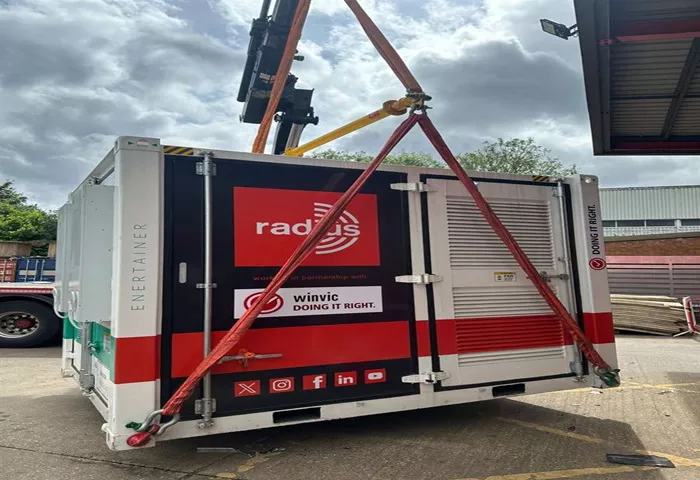BIRMINGHAM, ENGLAND — In a significant step towards sustainable construction practices, Birmingham’s Crown Place tower project is utilizing cutting-edge technology to reduce carbon emissions. The 33-storey building, located on Lancaster Street, is being constructed with the aid of a Potain MR 225A luffing jib tower crane powered by a rechargeable battery energy storage system (BESS), known as the Enertainer.
The Enertainer, a 2.6-square-meter (28 sq. ft.) unit weighing 7.3 tonnes, is equipped with 30,000 lithium-ion battery cells. This innovative system is designed to supplement grid power and manage the high energy demands of tower cranes, which have traditionally relied on diesel generators.
Innovative Energy Solutions for Tower Cranes
Electric tower cranes, while not new, have faced challenges due to their high power needs and difficulties in connecting to the electrical grid. The Enertainer addresses these issues by providing short bursts of high electric power necessary for lifting loads, a crucial advantage on construction sites where power demands can fluctuate significantly.
Rachel Swanston, marketing manager at Radius Group, the company supplying the crane, highlighted the growing demand for alternative power solutions in the construction industry. “This is driven by the industry’s focus on sustainability and efficiency,” Swanston said. Radius’ investment in energy storage systems represents a commitment to reducing reliance on traditional, less sustainable power sources.
Surge in Demand for BESS Technology
Ampd Energy, the Hong Kong-based manufacturer of the Enertainer, has seen a significant increase in demand for its products. Hayley Arckless, UK country manager for Ampd Energy, explained that the company developed the Enertainer to meet the specific power requirements of construction sites and to offer a more sustainable alternative to diesel generators.
Arckless emphasized the environmental benefits of the Enertainer, noting that each unit can save up to 130 tonnes of carbon dioxide per year compared to diesel generators. The system charges from a 320 – 440 V AC mains supply at a rate of 10 to 80 Amps and provides a reliable power source, even during outages.
Exploring Alternatives and Future Solutions
While the Enertainer represents a significant advancement, other technologies, such as flywheels and lead-acid batteries, also contribute to reducing the carbon footprint of construction equipment. Flywheels can store sudden spikes in electricity, while lead-acid batteries are used for stable load requirements. However, Arckless believes that the Enertainer offers a more comprehensive solution, capable of powering entire job sites.
Looking ahead, Ampd Energy is exploring ways to integrate its technology with hydrogen generators and fuel cells. “Hydrogen is an exciting technology, but it is cost-prohibitive at scale,” Arckless acknowledged. “By pairing a battery with a hydrogen generator, we aim to create a zero-emission, low-carbon power solution for construction.”
The Enertainer’s deployment at Crown Place marks a milestone in the construction industry’s journey towards more sustainable practices, showcasing how innovative energy solutions can drive significant environmental benefits.
Related topics:
- Eaton Unveils Expanded Transmission Portfolio at IAA Transportation 2024
- EU State of the Energy Union Report Highlights Progress Amid Challenges
- Japan’s Tepco Explores Renewable Bitcoin Mining with Innovative Agile Energy X Initiative

